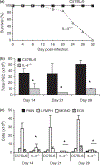IL-4(-/-) mice with lethal Mesocestoides corti infections--reduced Th2 cytokines and alternatively activated macrophages
- PMID: 19891612
- PMCID: PMC6714042
- DOI: 10.1111/j.1365-3024.2009.01151.x
IL-4(-/-) mice with lethal Mesocestoides corti infections--reduced Th2 cytokines and alternatively activated macrophages
Abstract
Protection against Mesocestoides corti, a cestode that invades vital organs, is dependent on the production of IL-4, as IL-4(-/-) mice were found to have higher parasite burdens when compared with wild-type mice. The goal of this study was to investigate the role of IL-4 in immunity to M. corti, focusing on the immunological profile and on potential mediators of pathology. IL-4(-/-) mice infected with M. corti showed 100% mortality by 32 days, whereas wild-type mice survived for approximately 1 year. Parasite burdens were significantly increased in the liver, peritoneal, and thoracic cavities of IL-4(-/-) mice, associated with impaired recruitment of inflammatory cells and a reduction in monocytes and macrophages. IL-5 production by splenocytes and expression in liver tissue was decreased in infected IL-4(-/-) mice compared with wild-type mice. In contrast, IL-4(-/-) mice produced increased amounts of IFNgamma and TNFalpha. Alternatively activated macrophages were a major feature of liver granulomas in wild-type mice evidenced by Arginase I expression, while livers from infected IL-4(-/-) mice showed impaired alternative macrophage activation without increased classical macrophage activation. Thus, lethality during M. corti infection of IL-4(-/-) mice is associated with decreased Th2 cytokines, increased Th1 cytokines and impairment of alternatively activated macrophages.
Figures






References
-
- Pollacco S, Nicholas WL, Mitchell GF & Stewart AC. T-cell dependent collagenous encapsulating response in the mouse liver to Mesocestoides corti (Cestoda). Int J Parasitol 1978; 8: 457–462. - PubMed
-
- Specht D & Widmer EA. Response of mouse liver to infection with tetrathyridia of Mesocestoides (Cestoda). J Parasitol 1972; 58: 431–437. - PubMed
-
- Rawat J, Dixon JB, Macintyre AR, McGarry HF & Taylor MJ. IL-4 dependent resistance to the tapeworm Mesocestoides corti (Cestoda) in mice. Parasite Immunol 2003; 25: 553–557. - PubMed
-
- Reed SG & Scott P. T-cell and cytokine responses in leishmaniasis. Curr Opin Immunol 1993; 5: 524–531. - PubMed
-
- Urban JF Jr, Madden KB, Svetic A, et al. The importance of Th2 cytokines in protective immunity to nematodes. Immunol Rev 1992; 127: 205–220. - PubMed
MeSH terms
Substances
Grants and funding
LinkOut - more resources
Full Text Sources

